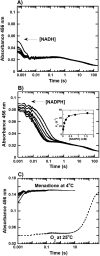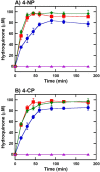A complete bioconversion cascade for dehalogenation and denitration by bacterial flavin-dependent enzymes
- PMID: 30282807
- PMCID: PMC6290146
- DOI: 10.1074/jbc.RA118.005538
A complete bioconversion cascade for dehalogenation and denitration by bacterial flavin-dependent enzymes
Abstract
Halogenated phenol and nitrophenols are toxic compounds that are widely accumulated in the environment. Enzymes in the had operon from the bacterium Ralstonia pickettii DTP0602 have the potential for application as biocatalysts in the degradation of many of these toxic chemicals. HadA monooxygenase previously was identified as a two-component reduced FAD (FADH-)-utilizing monooxygenase with dual activities of dehalogenation and denitration. However, the partner enzymes of HadA, that is, the flavin reductase and quinone reductase that provide the FADH- for HadA and reduce quinone to hydroquinone, remain to be identified. In this report, we overexpressed and purified the flavin reductases, HadB and HadX, to investigate their functional and catalytic properties. Our results indicated that HadB is an FMN-dependent quinone reductase that converts the quinone products from HadA to hydroquinone compounds that are more stable and can be assimilated by downstream enzymes in the pathway. Transient kinetics indicated that HadB prefers NADH and menadione as the electron donor and acceptor, respectively. We found that HadX is an FAD-bound flavin reductase, which can generate FADH- for HadA to catalyze dehalogenation or denitration reactions. Thermodynamic and transient kinetic experiments revealed that HadX prefers to bind FAD over FADH- and that HadX can transfer FADH- from HadX to HadA via free diffusion. Moreover, HadX rapidly catalyzed NADH-mediated reduction of flavin and provided the FADH- for a monooxygenase of a different system. Combination of all three flavin-dependent enzymes, i.e. HadA/HadB/HadX, reconstituted an effective dehalogenation and denitration cascade, which may be useful for future bioremediation applications.
Keywords: bioremediation; biotechnology; enzyme kinetics; enzyme mechanism; flavin; flavin adenine dinucleotide (FAD); flavoenzyme; halogenated phenol; nitrophenol; reductase.
© 2018 Pimviriyakul and Chaiyen.
Conflict of interest statement
The authors declare that they have no conflicts of interest with the contents of this article
Figures












Similar articles
-
Kinetic Mechanism of the Dechlorinating Flavin-dependent Monooxygenase HadA.J Biol Chem. 2017 Mar 24;292(12):4818-4832. doi: 10.1074/jbc.M116.774448. Epub 2017 Feb 3. J Biol Chem. 2017. PMID: 28159841 Free PMC article.
-
Structural insights into a flavin-dependent dehalogenase HadA explain catalysis and substrate inhibition via quadruple π-stacking.J Biol Chem. 2021 Aug;297(2):100952. doi: 10.1016/j.jbc.2021.100952. Epub 2021 Jul 10. J Biol Chem. 2021. PMID: 34252455 Free PMC article.
-
Formation and stabilization of C4a-hydroperoxy-FAD by the Arg/Asn pair in HadA monooxygenase.FEBS J. 2023 Jan;290(1):176-195. doi: 10.1111/febs.16591. Epub 2022 Aug 17. FEBS J. 2023. PMID: 35942637
-
The FMN-dependent two-component monooxygenase systems.Arch Biochem Biophys. 2010 May;497(1-2):1-12. doi: 10.1016/j.abb.2010.02.007. Epub 2010 Mar 1. Arch Biochem Biophys. 2010. PMID: 20193654 Review.
-
Flavin dependent monooxygenases.Arch Biochem Biophys. 2014 Feb 15;544:2-17. doi: 10.1016/j.abb.2013.12.005. Epub 2013 Dec 17. Arch Biochem Biophys. 2014. PMID: 24361254 Review.
Cited by
-
Microbial degradation of halogenated aromatics: molecular mechanisms and enzymatic reactions.Microb Biotechnol. 2020 Jan;13(1):67-86. doi: 10.1111/1751-7915.13488. Epub 2019 Sep 29. Microb Biotechnol. 2020. PMID: 31565852 Free PMC article. Review.
-
Monooxygenation of aromatic compounds by flavin-dependent monooxygenases.Protein Sci. 2019 Jan;28(1):8-29. doi: 10.1002/pro.3525. Protein Sci. 2019. PMID: 30311986 Free PMC article. Review.
-
Mechanistic insights into the dual activities of the single active site of l-lysine oxidase/monooxygenase from Pseudomonas sp. AIU 813.J Biol Chem. 2020 Aug 7;295(32):11246-11261. doi: 10.1074/jbc.RA120.014055. Epub 2020 Jun 11. J Biol Chem. 2020. PMID: 32527725 Free PMC article.
-
Substrate Electronics Dominate the Rate of Reductive Dehalogenation Promoted by the Flavin-Dependent Iodotyrosine Deiodinase.Biochemistry. 2023 Apr 4;62(7):1298-1306. doi: 10.1021/acs.biochem.3c00041. Epub 2023 Mar 9. Biochemistry. 2023. PMID: 36892456 Free PMC article.
-
Evolution of pollutant biodegradation.Appl Microbiol Biotechnol. 2025 Feb 4;109(1):36. doi: 10.1007/s00253-025-13418-0. Appl Microbiol Biotechnol. 2025. PMID: 39903283 Free PMC article. Review.
References
-
- Igbinosa E. O., Odjadjare E. E., Chigor V. N., Igbinosa I. H., Emoghene A. O., Ekhaise F. O., Igiehon N. O., and Idemudia O. G. (2013) Toxicological profile of chlorophenols and their derivatives in the environment: the public health perspective. Scientific World J. 2013, 1–11 10.1155/2013/460215 - DOI - PMC - PubMed
-
- Pera-Titus M., Garcia-Molina V., Banos M. A., Gimenez J., and Esplugas S. (2004) Degradation of chlorophenols by means of advanced oxidation processes: a general review. Appl. Catal. B-Environ 47, 219–256 10.1016/j.apcatb.2003.09.010 - DOI
Publication types
MeSH terms
Substances
LinkOut - more resources
Full Text Sources

